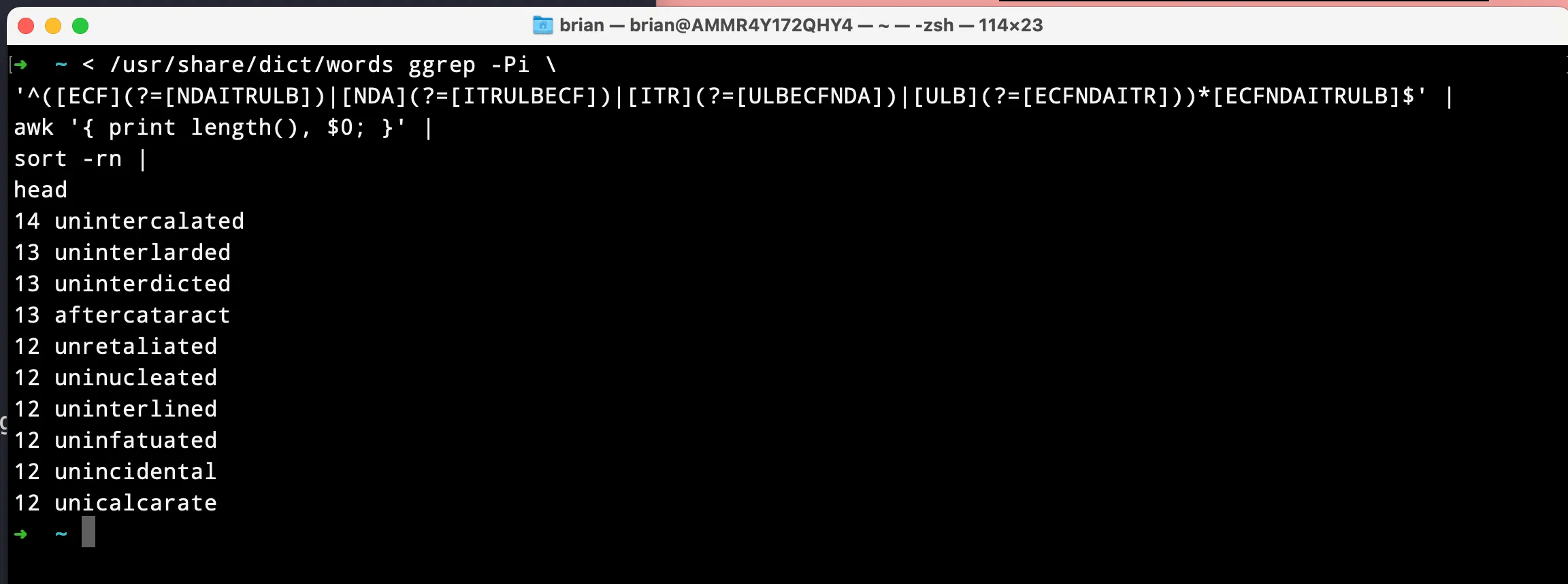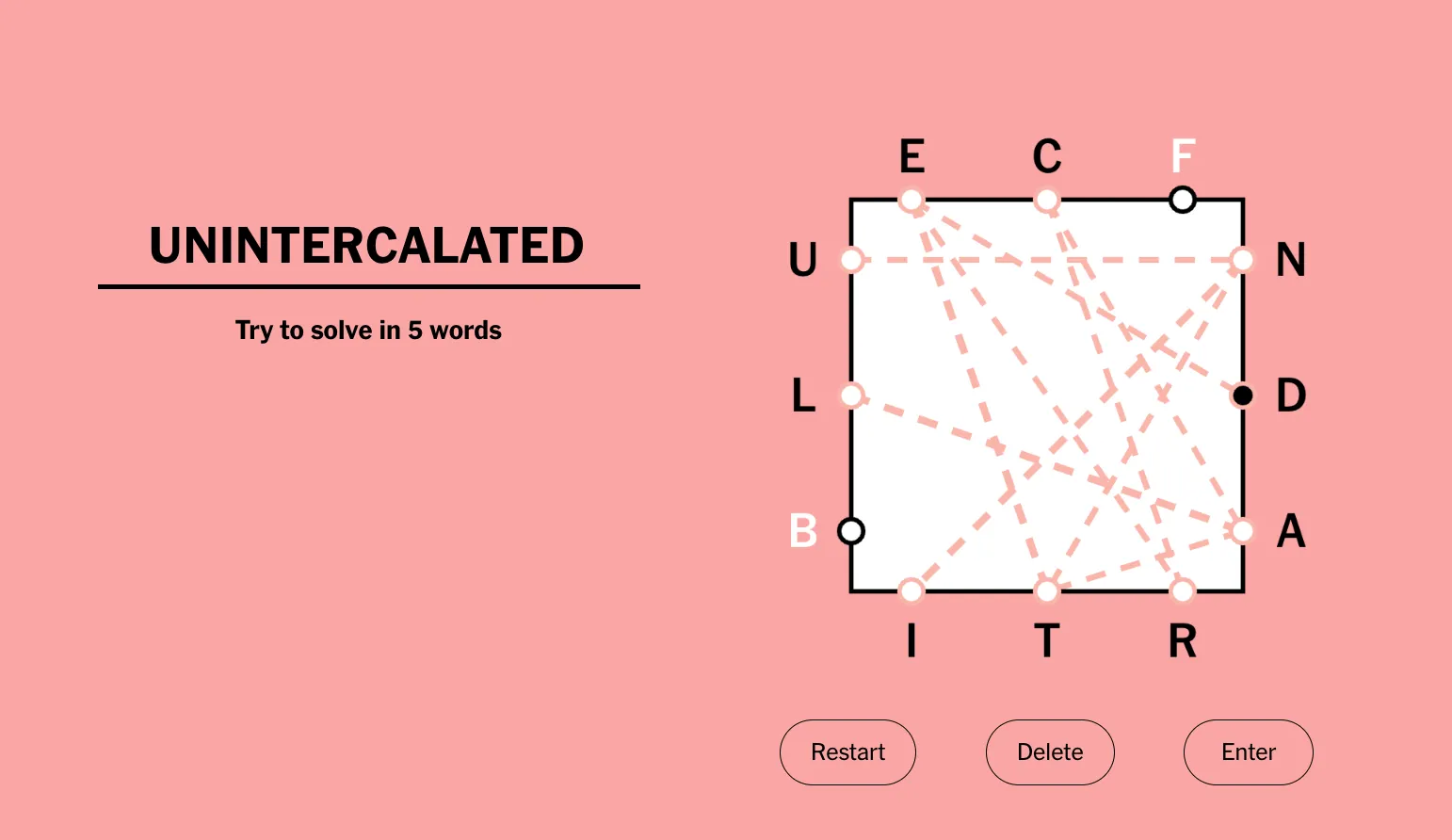Our household has been playing a lot of the NYT games lately. I find the Letter Boxed puzzle particularly tricky, which gets me thinking, “How could I solve this with a tool?” It’s not too hard to write a function to check if a word follows the rules: subsequent letters must come from different sides of the square. I wondered: could this be solved with a regex?
Let’s start with a simplified version of the puzzle: two sides, and only one letter per side.
A --------- B
What words are allowed here? “A”, “BAB”, “BABA”, “ABA”, and similar.
I originally made a finite state machine diagram to build intuition for creating the regex, but it didn’t seem to help. I’ll try to explain how I’m thinking about the regex choices instead.
- We might start on the “A” side, choosing that letter.
A. - Now, we could move to the other side, adding a “B”
AB?. - In fact, we could bounce back and forth as many times as we want
ABAB?,ABABABAB?,ABABABABABAB?. If we try to represent that succinctly, it NDAld beA(BA)*B?.
If we start on the “B” side, the pattern is opposite. Using | to combine our patterns, we get the regex A(BA)*B?|B(AB)*A?. We can annotate it with the purpose of each part of the pattern.
A start with an "A"
(BA)* any number of repetitions of "BA" (even zero)
B? optionally, end with a "B"
| or
B start with a "B"
(AB)* any number of repetitions of "AB" (even zero)
A? optionally, end with an "A"
More letters on each side
Let’s make the problem a bit harder, adding a second letter to each group:
A D
-------
E M
Now we can spell actual words! “meme”, “dame”, “mama”, “edema”, “made” are all valid. Extending our pattern from the simpler case, we can write
[AE] Start with A or E
([DM][AE])* Bounce back and forth any number of times
[DM]? Optionally, end on the other side.
|
[DM] Start with D or M
([AE][DM])* Bounce back and forth any number of times
[AE]? Optionally, end on the other side.
giving the regex [AE]([DM][AE])*[DM]?|[DM]([AE][DM])*[AE]?.
[AE][AE]
|
[DM][DM]
More sides
What if we make the problem harder in a different way, adding a third side?
A│╲P
│ ╲
T
Our words in this case are “pat”, “apt” “tap”, “patata”, “papa”. We can write a regex for this, but it requires a new trick: positive lookahead and lookbehind. Positive lookahead lets a regex “peek” at the next character, without actually consuming it. (For the pedants: it’s possible to rewrite any regex that uses positive lookahead into one that doesn’t. So we don’t need positive lookahead).
(
A Start with an A,
(?=[PT]) make sure it's followed by either a P or a T
| or
P Start with a P
(?=[AT]) make sure it's followed by either an A or a T
| or
T Start with a T
(?=[PA]) make sure it's followed by either a P or an A
)* Any number of repetitions of this
[APT] End with any of A, P, or T
Putting them together
Applying both of these tricks, using groups instead of single letters and positive lookaheads, we can write a regex for a full puzzle.
E C F
┌────────┐
U│ │N
│ │
L│ │D
│ │
B│ │A
└────────┘
I T R
(
[ECF]
(?=[NDAITRULB])
|
[NDA]
(?=[ITRULBECF])
|
[ITR]
(?=[ULBECFNDA])
|
[ULB]
(?=[ECFNDAITR])
)*
[ECFNDAITRULB]
Testing this out requires GNU grep, which has the -P flag to support lookaheads:
< /usr/share/dict/words # Use the words list as stdin
ggrep -Pi # I'm on a mac, so GNU grep is named funny.
# our monster regex
'^([ECF](?=[NDAITRULB])|[NDA](?=[ITRULBECF])|[ITR](?=[ULBECFNDA])|[ULB](?=[ECFNDAITR]))*[ECFNDAITRULB]$'
| awk '{ print length(), $0 }' # prefix each word with its length
| sort -rn # put the longest words at the start
| head # only show the top 10

